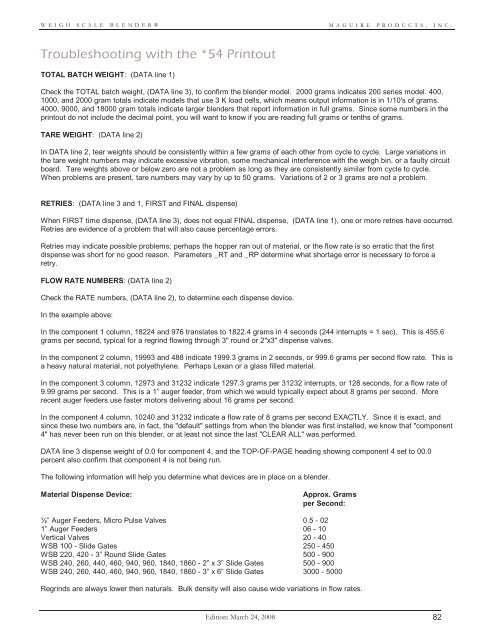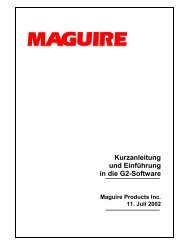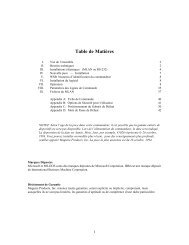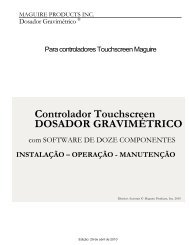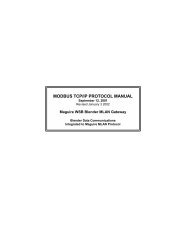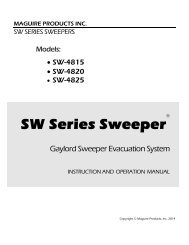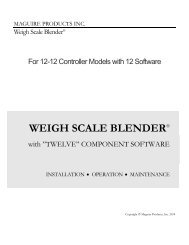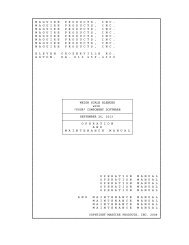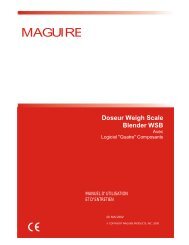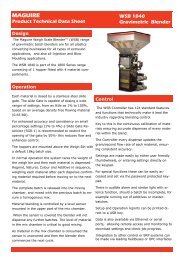WEIGH SCALE BLENDER® - Maguire Products
WEIGH SCALE BLENDER® - Maguire Products
WEIGH SCALE BLENDER® - Maguire Products
Create successful ePaper yourself
Turn your PDF publications into a flip-book with our unique Google optimized e-Paper software.
<strong>WEIGH</strong> <strong>SCALE</strong> <strong>BLENDER®</strong><br />
MAGUIRE PRODUCTS, INC.<br />
Troubleshooting with the *54 Printout<br />
TOTAL BATCH <strong>WEIGH</strong>T: (DATA line 1)<br />
Check the TOTAL batch weight, (DATA line 3), to confirm the blender model. 2000 grams indicates 200 series model. 400,<br />
1000, and 2000 gram totals indicate models that use 3 K load cells, which means output information is in 1/10's of grams.<br />
4000, 9000, and 18000 gram totals indicate larger blenders that report information in full grams. Since some numbers in the<br />
printout do not include the decimal point, you will want to know if you are reading full grams or tenths of grams.<br />
TARE <strong>WEIGH</strong>T: (DATA line 2)<br />
In DATA line 2, tear weights should be consistently within a few grams of each other from cycle to cycle. Large variations in<br />
the tare weight numbers may indicate excessive vibration, some mechanical interference with the weigh bin, or a faulty circuit<br />
board. Tare weights above or below zero are not a problem as long as they are consistently similar from cycle to cycle.<br />
When problems are present, tare numbers may vary by up to 50 grams. Variations of 2 or 3 grams are not a problem.<br />
RETRIES: (DATA line 3 and 1, FIRST and FINAL dispense)<br />
When FIRST time dispense, (DATA line 3), does not equal FINAL dispense, (DATA line 1), one or more retries have occurred.<br />
Retries are evidence of a problem that will also cause percentage errors.<br />
Retries may indicate possible problems; perhaps the hopper ran out of material, or the flow rate is so erratic that the first<br />
dispense was short for no good reason. Parameters _RT and _RP determine what shortage error is necessary to force a<br />
retry.<br />
FLOW RATE NUMBERS: (DATA line 2)<br />
Check the RATE numbers, (DATA line 2), to determine each dispense device.<br />
In the example above:<br />
In the component 1 column, 18224 and 976 translates to 1822.4 grams in 4 seconds (244 interrupts = 1 sec). This is 455.6<br />
grams per second, typical for a regrind flowing through 3" round or 2"x3" dispense valves.<br />
In the component 2 column, 19993 and 488 indicate 1999.3 grams in 2 seconds, or 999.6 grams per second flow rate. This is<br />
a heavy natural material, not polyethylene. Perhaps Lexan or a glass filled material.<br />
In the component 3 column, 12973 and 31232 indicate 1297.3 grams per 31232 interrupts, or 128 seconds, for a flow rate of<br />
9.99 grams per second. This is a 1” auger feeder, from which we would typically expect about 8 grams per second. More<br />
recent auger feeders use faster motors delivering about 16 grams per second.<br />
In the component 4 column, 10240 and 31232 indicate a flow rate of 8 grams per second EXACTLY. Since it is exact, and<br />
since these two numbers are, in fact, the "default" settings from when the blender was first installed, we know that "component<br />
4" has never been run on this blender, or at least not since the last "CLEAR ALL" was performed.<br />
DATA line 3 dispense weight of 0.0 for component 4, and the TOP-OF-PAGE heading showing component 4 set to 00.0<br />
percent also confirm that component 4 is not being run.<br />
The following information will help you determine what devices are in place on a blender.<br />
Material Dispense Device:<br />
Approx. Grams<br />
per Second:<br />
½” Auger Feeders, Micro Pulse Valves 0.5 - 02<br />
1” Auger Feeders 06 - 10<br />
Vertical Valves 20 - 40<br />
WSB 100 - Slide Gates 250 - 450<br />
WSB 220, 420 - 3” Round Slide Gates 500 - 900<br />
WSB 240, 260, 440, 460, 940, 960, 1840, 1860 - 2” x 3” Slide Gates 500 - 900<br />
WSB 240, 260, 440, 460, 940, 960, 1840, 1860 - 3” x 6” Slide Gates 3000 - 5000<br />
Regrinds are always lower then naturals. Bulk density will also cause wide variations in flow rates.<br />
Edition: March 24, 2008 82


